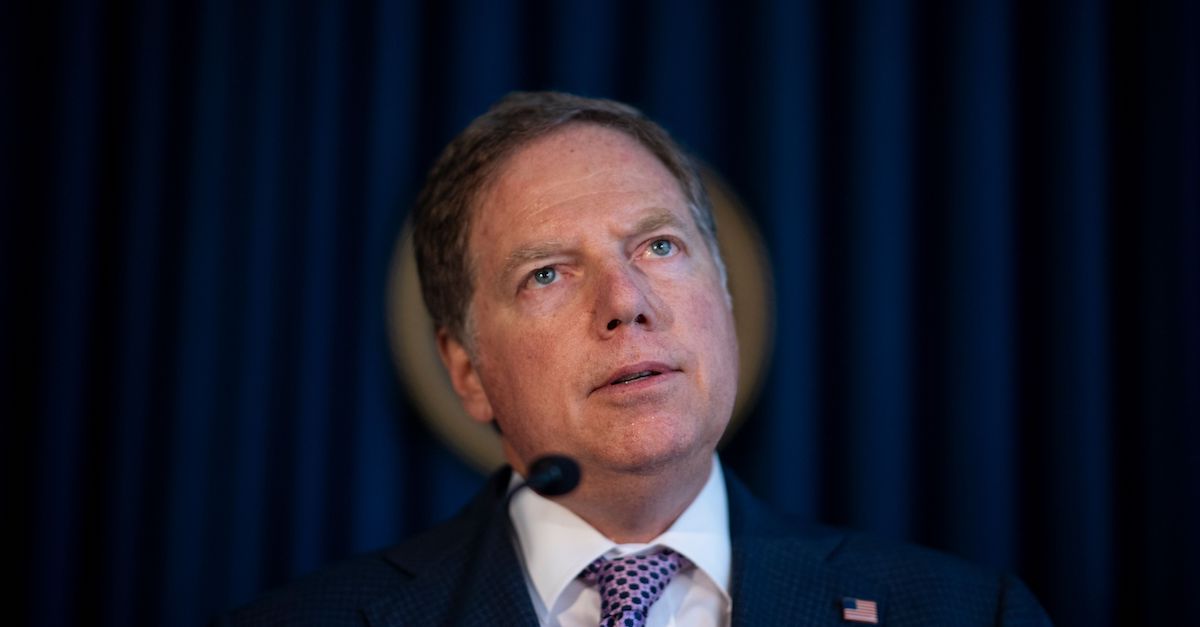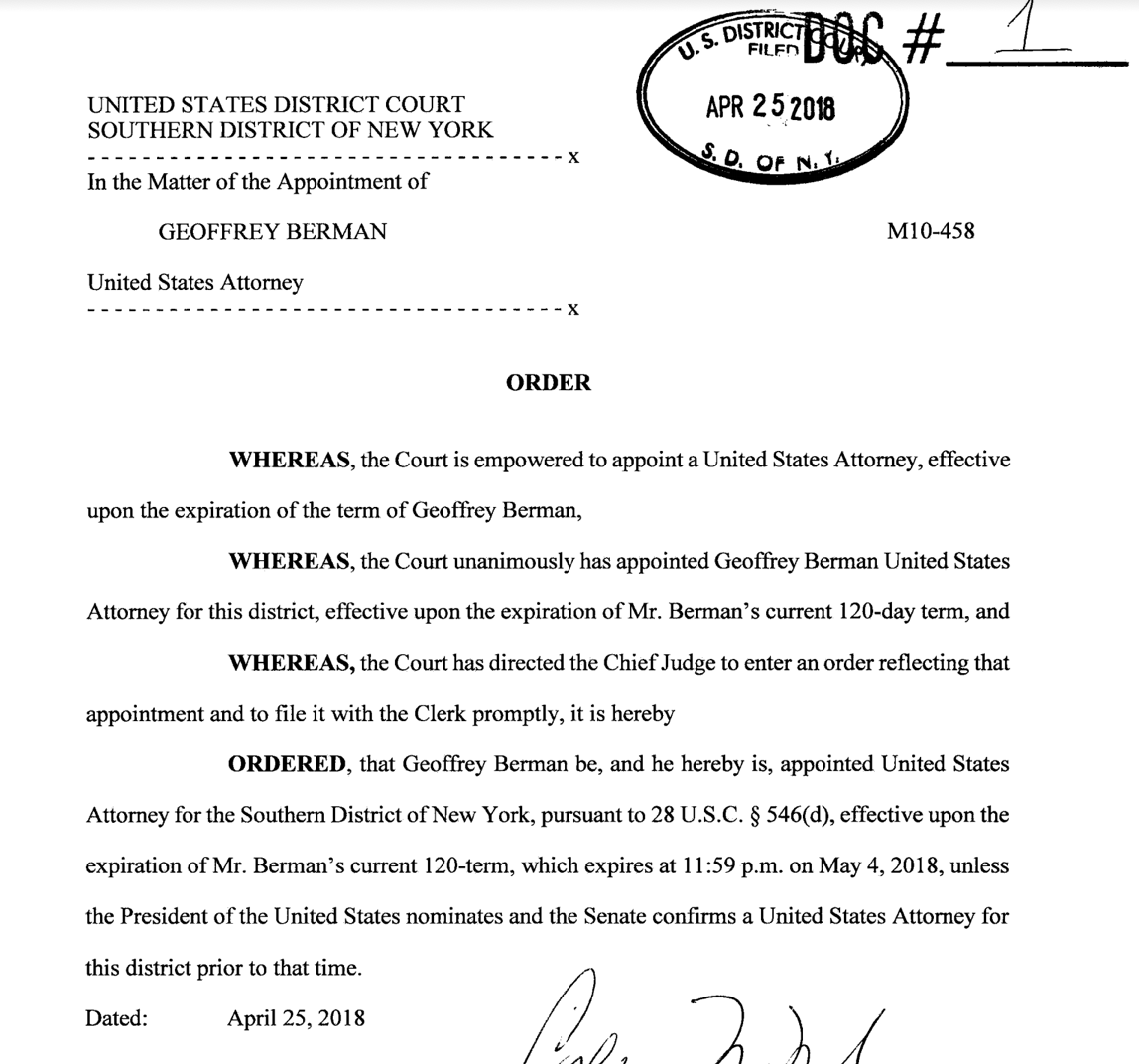
Attorney General William Barr announced Friday night that the U.S. Attorney for the Southern District of New York, who was appointed to his position by a federal court, was resigning from his post and being replaced by an acting U.S. Attorney. The problem is that SDNY’s Geoffrey Berman doesn’t see it the same way and says he has no intention of stepping down. That’s likely because Berman thinks he is entitled, by federal law, to remain in that role until the Republican-led Senate confirms a nominee.
Berman oversaw the prosecution of former Trump lawyer Michael Cohen. His office also brought criminal cases against Trump lawyer Rudy Giuliani’s former business associates Lev Parnas and Igor Fruman. Berman’s office is currently investigating Giuliani. And under Berman’s leadership, SDNY famously brought sex-trafficking charges against the since-deceased Jeffrey Epstein. Nor should the SDNY prosecution of Turkish state-owned bank Halkbank be forgotten.
But Barr said Friday that, with Berman out, an acting replacement is ready to step in, and that President Donald Trump already has a permanent replacement for Berman in mind. It’s been reported that Barr forced Berman out.
“I am pleased to announce that President Trump intends to nominate Jay Clayton, currently the Chairman of the Securities and Exchange Commission, to serve as the next United States Attorney for the Southern District of New York. For the past three years, Jay has been an extraordinarily successful SEC Chairman, overseeing efforts to modernize regulation of the capital markets, protect Main Street investors, enhance American competitiveness, and address challenges ranging from cybersecurity issues to the COVID-19 pandemic,” the statement from Barr began. “His management experience and expertise in financial regulation give him an ideal background to lead the United States Attorney’s Office for the Southern District of New York, and he will be a worthy successor to the many historic figures who have held that post. On behalf of the President, I thank Jay for accepting this nomination, and I look forward to working with him soon.”
Jay Clayton has never been a prosecutor, but he is nonetheless in line to lead, perhaps, the most storied U.S. Attorney’s Office in the nation.
Barr said that, in lieu of Clayton’s confirmation by the Senate, he himself recommended that Trump appoint Craig Carpenito, the U.S. Attorney for the District of New Jersey, to step in as acting SDNY U.S. Attorney.
Barr said that Carpenito’s appointment would be effective as of July 3 and that he expected Berman to work with Carpenito to “ensure a smooth transition.” Barr thanked Berman and said the outgoing U.S. Attorney for SDNY is “stepping down after two-and-a-half years of service as United States Attorney for the Southern District of New York.”
There are a couple of problems with this. First of all, Berman, who donated to the Trump campaign in 2016, released a statement of his own saying that he has no intention of stepping down and that he has not done so.
“I learned in a press release from the Attorney General tonight that I was ‘stepping down’ as United States Attorney,” Berman said. “I have not resigned, and have no intention of resigning, my position, to which I was appointed by the Judges of the United States District Court for the Southern District of New York. I will step down when a presidentially appointed nominee is confirmed by the Senate. Until then, our investigations will move forward without delay or interruption. I cherish every day that I work with the men and women of this Office to pursue justice without fear or favor – and intend to ensure that this Office’s important cases continue unimpeded.”
Berman’s statement contained the second problem with the scenario.
Let’s assume the U.S. Senate will take up Clayton’s nomination quickly and install him on a party line vote. Berman noted that he was appointed to his position by the U.S. District Court for the Southern District of New York not the President. In 2018, then-Attorney General Jeff Sessions first appointed Berman as interim SDNY U.S. Attorney. After the 120-day interim stint expired, the court appointed Berman to his current position. Trump never sent Berman’s nomination to the Senate.
The April 2018 court order said that Berman was appointed U.S. Attorney “unless the President of the United States nominates and the Senate confirms a United States Attorney for this district […]”.

The court cited to 28 U.S.C. § 546(d), which says:
(d) If an appointment expires under subsection (c)(2), the district court for such district may appoint a United States attorney to serve until the vacancy is filled. The order of appointment by the court shall be filed with the clerk of the court.
According to University of Texas law Prof. Steven Vladeck, “[t]here’s a pretty good argument that, per the plain language of 28 U.S.C. § 546(d)” Berman “gets to keep serving in that post until the *vacancy* is filled (through Senate confirmation of a permanent successor).”
In short, per Vladeck, the statute suggests that Carpenito cannot replace Berman in an acting role—and in the perhaps unlikely scenario that Clayton’s nomination dwindles and dies in Mitch McConnell’s Senate, Berman would remain in his position. Berman’s statement reflected this view.
Georgetown University Law Professor Marty Lederman countered, however, that the DOJ’s longstanding view, as expressed through the Office of Legal Counsel, is that the president can remove the court-appointed Berman, while Barr can’t:
This responds to your request concerning whether the power to remove a U.S. Attorney appointed by a district court pursuant to 28 U.S.C. § 546 is vested in the President, the Attorney General, or the appointing court. To our knowledge, the question is one of first impression.
Pursuant to 28 U.S.C. § 541(a), the President appoints U.S. Attorneys by and with the advice and consent of the Senate. Subsection (c) of that section provides that “ [e]ach United States Attorney is subject to removal by the President.” The question is whether the President’s removal power under subsection (c) extends to U.S. Attorneys appointed by the court pursuant to § 546, or whether they can be removed only by the court that appointed them. In our view the first interpretation is the correct one.
[…]
Whether the President should exercise the power of removal is, of course, a question of policy. We note in this connection that Carey v. United States, 132 Ct. Cl. 397 (1955), stands for the proposition that the President need not actually sign removal papers, but that he may leave to the Attorney General the implementation of an oral Presidential decision to remove a U.S. Attorney appointed with the advice and consent of the Senate; indeed, that the President may authorize the Attorney General to do what he feels is warranted and then orally approve the action taken by the Attorney General. Carey at 401-403.4 But we do not recommend this course of action in the situation at hand, since the incumbent U.S. Attorney apparently has the backing of the district court. That court might react unfavorably to any action that does not carefully comport with the letter of the statute.
NYU Law Professor Ryan Goodman pointed to the United States v. Solomon case, which happens to have been decided in the SDNY. That decision noted that “the President may, at any time, remove the judicially appointed United States Attorney, pursuant to 28 U.S.C. § 504 […] regardless of the nature of his appointment.”
Regardless of who is right, it seems a politically charged legal fight could be brewing that could determine the future of certain sensitive investigations.
Former SDNY U.S. Attorney Preet Bharara, who knows what it is like to be fired by President Trump, immediately raised the question: “Why does a president get rid of his own hand-picked US Attorney in SDNY on a Friday night, less than 5 months before the election?”
[Image via JOHANNES EISELE/AFP via Getty Images]
Have a tip we should know? [email protected]